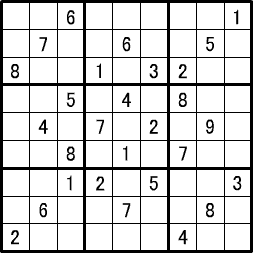|
WHAT'S COOL IN JAPAN Sudoku | ||||
People in Europe and the United States are going wild over a number puzzle called sudoku, which evolved into its present form in Japan. Sudoku's popularity in Japan was limited to a small group of devotees, but in the autumn of 2004 it suddenly burst onto the scene in puzzle-loving Britain. First The Times, a famous British newspaper, began printing a daily sudoku puzzle, and then other papers started doing so too. Sudoku was covered by well-known magazines, and as more and more people became hooked on it, books of sudoku puzzles became best-sellers. The sudoku boom has now spread all over the world. The puzzles appear in major newspapers in the United States and France, and sudoku books have been published in a number of countries, including Germany. In Japan, reports about the popularity of sudoku abroad have prompted people to take a fresh look at this home-grown puzzle. Some Japanese elementary schools have even begun incorporating sudoku into math classes. The secret of sudoku's popularity is that while the rules are easy enough for a child to understand, solving the puzzles can be maddeningly difficult. Each sudoku puzzle consists of a square grid of nine rows by nine columns, and these are further grouped into nine three-by-three blocks. The player must write a number from 1 to 9 in each square, ensuring that each number appears just once in each row, column, and block. Numbers are pre-printed in some of the squares as clues - the more clues there are the easier the puzzle is to complete. This type of puzzle is said to have originally been thought up by a Swiss mathematician in the eighteenth century, and it appeared in a US puzzle magazine in the 1970s under the name Number Place. In the 1980s, a Japanese company called Nikoli, which makes puzzle magazines, published puzzles like this under the name sudoku. Nikoli refined the puzzle by reducing the number of digits initially provided in the grid and lining up the initial numbers in symmetrical patterns to make it more pleasing to the eye. The most difficult part of creating the puzzles is said to be the task of reducing the initial numbers. By the way, the word sudoku is made up of two kanji characters - su, meaning numbers, and doku, meaning single or alone. The word can be interpreted as meaning "Only single-digit numbers can be used" or "Numbers can only be used once." Today, the word sudoku has come to be known and understood throughout the world. So far 22 books of sudoku have been published in Japan. Sudoku's big break came about because a New Zealander happened to come upon a sudoku book in Japan, liked it, and took it in to The Times in London. The paper began running the puzzles, and the rest is history. Sudoku is considered useful in helping children to develop logical reasoning. Some beginner puzzles can be found on the Internet. Why not give it a try? |
